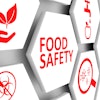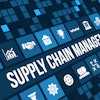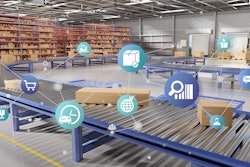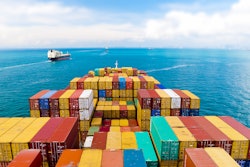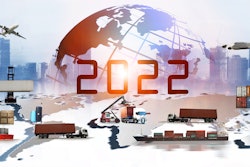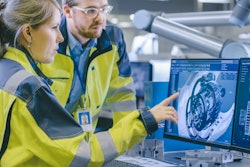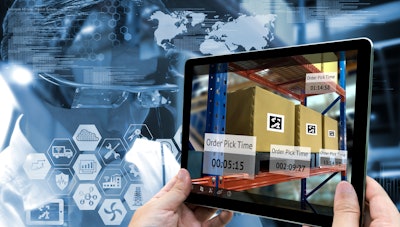
When 2021 hit, the world was ready for the New Year. Even if it brought with it a New Normal -- new way of doing business, a new way to shop for groceries and more -- the turning of the calendar meant putting a year of supply chain disruptions, restaurant closures and constant pivoting behind us.
But, then, on March 23, a stranded Evergreen container ship blocked navigation in Egypt’s Suez Canal, setting the stage for what would be a slew of supply chain disruptions after supply chain disruptions.
Suddenly, 2021 was quickly becoming a mirrored reflection of the year prior.
Then came the ransomware attacks, internet outages, container ships stuck at bay, bridge closures, driver shortages, ingredient shortages, natural disasters and more.
The hits just kept on hitting.
And, industry experts are already showing signs of struggle for 2022 into 2023, as routes to import/export remain clogged, ports continue to be backed up, cost of doing business increases and the labor shortage exists.
That’s because supply chains are messy. And, they’re only going to get worse before they get better.
In Food Logistics’ Nov/Dec 2021 issue, editor-in-chief Marina Mayer talks with several industry experts about the state of the supply chain and what’s in store for 2022.
Here’s an interview with Michael Zimmerman, partner, Kearney, who details why an emphasis on software in the New Year will help companies face adversity, with excerpts publishing in Food Logistics’ Nov/Dec 2021 issue. [CLICK HERE to read the article in full].
Food Logistics: 2021 started off with supply chain disruption after supply chain disruption. From the Suez Canal blockage and natural disasters to ransomware attacks and an industry-wide labor shortage, the supply chain industry is having to prove its resiliency over and over again. Looking into 2022, what does the state of the supply chain look like?
Michael Zimmerman: Like a boxer coming off the ropes after a severe battering, supply chains managers will be changing their plans and strategy substantially. The increasing incidence of disruptions means that optimized, single-sourced, just-in-time supply chain planning and resilience in the face of adversity are simply not enough.
Company boards and the C-suite will be seeking more optionality and more capabilities built into their supply chains, and that is going to mean more inventory, more suppliers, more routings for products and more ways to plan for (and adapt to) the unexpected.
Companies prefer to deal with the higher costs of planning for and committing to more options than to deal with lost sales and lost market share. So, we expect changes from single sourcing to one offshore supplier in favor of multiple product and materials sourcing from both abroad and domestically. Similarly, we are anticipating more commitments to minimum capacity buys and more storage.
Look for a reduction in SKUs, as the ability to supply reliably supplants the ability to supply variety; while companies are ready to pay for preparing for all that optionality, they have to compensate somewhere and not multiplying that cost by an ever-widening array of product variations, and in fact reversing the SKU proliferation is the first stop.
Food Logistics: The cold food chain continues to face a host of risk/security challenges. What can companies be doing now to adapt for the future?
Zimmerman: The greatest risk for any company in the business of food provision is that their product sickens consumers. With the near instant sharing by consumers and news outlets of any safety or freshness problem, not to mention corporate and personal responsibility and regulatory enforcement, it’s clear that the stakes keep getting higher to minimize risk and maximize security. Companies in this space are therefore focusing the most resources on information and visibility so that they can identify and even anticipate risks in the cold chain. That means more use of product and shipment track-and-trace devices and the software to sustain, interpret and communicate status. Companies are investing in these technologies with the explicit objective of better knowing where their products are, how much time they spend in each segment of the journey, at what temperature they are at all times and anticipating where delays are likely so that they can take corrective action.
Food Logistics: In terms of transportation, what are some of the trends you’re seeing for 2022? How do emerging technologies like blockchain, Internet of Things, cloud-based, etc. play a role in the evolution of transportation in the cold food chain?
Zimmerman: Shippers saw the value of captive (private and dedicated) fleets during the pandemic and will be ramping them up further in 2022. The cost differential between common carriers and captive fleets has shrunk, and common carrier tender acceptance and on-time delivery has dropped; likewise, shippers are getting better at deploying their captive fleets efficiently and finding outlets for any remaining capacity.
The Internet of Things should make the visibility of all shipments clearer and since the stakes are higher in the cold chain, look for investments to lead in that space over dry freight.
Food Logistics: Let’s talk supply chain visibility. What is your company – or what should companies – be doing to improve their own supply chain visibility?
Zimmerman: Right now, there is an emphasis on software [that] brings together the myriad of sources of information -- data from track-and-trace devices, apps truck ELDs, EDI-generated signals and APIs. Such software helps piece together a better picture of where shipments and the products in them are or were last seen, to then provide users with not only better visibility but better anticipation and better adaptation so that logistics and supply chains can plan and execute better.
Food Logistics: The labor shortage is a real thing, and it’s impacting several facets of the supply chain. What is your company – or what should companies – be doing to hire, onboard and retain good quality supply chain workers?
Zimmerman: Focusing on logistics, beyond the obvious financial incentives, shippers should work on making the driver experience better, which includes better treatment on-site at the origin and destination of each lane, treating them with respect at the various check-in points, having attractive waiting areas and clean bathrooms and even showers at the ready. In shipping and logistics, the basics count for a lot.
Food Logistics: The COVID-19 pandemic put extra emphasis on food safety and worker safety. What is the state of food safety and worker safety going into the New Year?
Zimmerman: It is probably better than it has ever been. Accidents always receive a lot of attention, but the fact is that stringent regulation and enforcement have dramatically reduced the incidence or workplace accidents and harm by food. More attention should be paid to the amount of sugar and fat in food deemed to be “safe.”
Food Logistics: When it comes to grocery retail shopping and/or foodservice establishments, what are some trends you see sticking around post-pandemic, and which ways of doing business will somewhat go away?
Zimmerman: Grocery store brands, otherwise known as private label, will keep growing as consumers become more familiar with and trust them. Grocers will keep making improvements in the shopper experience, making buy-anywhere-get-anywhere the rule for all shoppers.
Food Logistics: What are some things not addressed above that may be pertinent to our readers?
Zimmerman: Consumers will certainly continue to care more about sustainable packaging, production and logistics in the goods they buy, and producers, logisticians and retailers should be strong in their pursuit and clear in their communications of sustainability initiatives.
[CLICK HERE to read the article in full].

